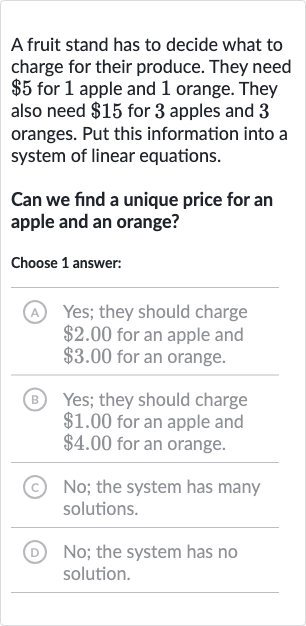AI tutor
Welcome to Bytelearn!
Let’s check out your problem:

A fruit stand has to decide what to charge for their produce. They need for apple and orange. They also need for apples and oranges. Put this information into a system of linear equations.Can we find a unique price for an apple and an orange?Choose answer:A Yes; they should charge for an apple and for an orange.B Yes; they should charge for an apple and for an orange.(C) No; the system has many solutions.D ; the system has no solution.
Full solution
Q. A fruit stand has to decide what to charge for their produce. They need for apple and orange. They also need for apples and oranges. Put this information into a system of linear equations.Can we find a unique price for an apple and an orange?Choose answer:A Yes; they should charge for an apple and for an orange.B Yes; they should charge for an apple and for an orange.(C) No; the system has many solutions.D ; the system has no solution.
- Equations based on fruit cost: Let's denote the cost of an apple as 'a' and the cost of an orange as 'o'. The information given can be translated into two equations based on the cost of the fruits.First equation: (since for apple and orange)Second equation: (since for apples and oranges)
- Simplifying the second equation: We can simplify the second equation by dividing all terms by to make it easier to compare with the first equation.Simplified second equation:
- Identical equations: Now we have two identical equations:This means that we cannot find a unique solution for and because the two equations are the same and do not provide distinct information to solve for two variables.
- No unique solution: Since we have two identical equations, the system of equations does not have a unique solution. Instead, it has infinitely many solutions because any value of 'a' and 'o' that satisfies the equation will be a solution to the system.
More problems from Solve a system of equations using any method: word problems
QuestionGet tutor help
QuestionGet tutor help
